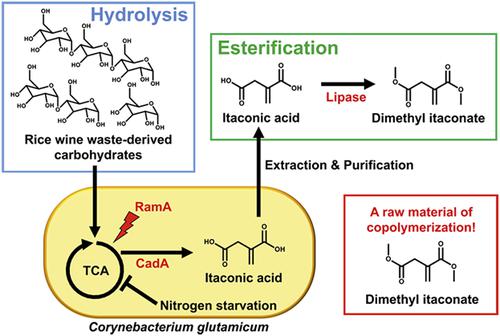当前位置:
X-MOL 学术
›
Biotechnol. J.
›
论文详情
Our official English website, www.x-mol.net, welcomes your
feedback! (Note: you will need to create a separate account there.)
Bio-Based Production of Dimethyl Itaconate From Rice Wine Waste-Derived Itaconic Acid
Biotechnology Journal ( IF 3.2 ) Pub Date : 2017-09-15 , DOI: 10.1002/biot.201700114 Young-Chul Joo 1 , Seung Kyou You 1 , Sang Kyu Shin 1 , Young Jin Ko 1 , Ki Ho Jung 1 , Sang A. Sim 1 , Sung Ok Han 1
Biotechnology Journal ( IF 3.2 ) Pub Date : 2017-09-15 , DOI: 10.1002/biot.201700114 Young-Chul Joo 1 , Seung Kyou You 1 , Sang Kyu Shin 1 , Young Jin Ko 1 , Ki Ho Jung 1 , Sang A. Sim 1 , Sung Ok Han 1
Affiliation

|
Dimethyl itaconate is an important raw material for copolymerization, but it is not synthesized from itaconic acid by organisms. Moreover, Corynebacterium glutamicum is used as an important industrial host for the production of organic acids, but it does not metabolize itaconic acid. Therefore, the biosynthetic route toward dimethyl itaconate from itaconic acid is highly needed. In this study, a biological procedure for dimethyl itaconate production is developed from rice wine waste-derived itaconic acid using the engineered C. glutamicum strain. The first step is to investigate the effect of the co-overexpression of the codon-optimized cis-aconitic acid decarboxylase (CadA*) and a transcriptional regulator of genes involved in acetic acid metabolism (RamA) on itaconic acid production. The second step is to convert itaconic acid into dimethyl itaconate by lipase-catalyzed esterification. The CadA* and RamA-overexpressing CG4 strain increases the itaconic acid concentration under N-starvation with glucose and acetic acid compared with the concentration produced in the base mCGXII medium with glucose. Furthermore, the rice wine waste-derived itaconic acid is successfully converted into dimethyl itaconate using lipase from Rhizomucor miehei and a methanol substrate. This study is the first trial for bio-based production of dimethyl itaconate from rice wine waste-derived itaconic acid. Dimethyl itaconate is an important raw material for copolymerization, but it is not synthesized from itaconic acid by organisms. An eco-friendly procedure is successfully developed for dimethyl itaconate production from rice wine waste-derived itaconic acid using the engineered Corynebacterium glutamicum strain. This results obtained in this study demonstrate the potential for bio-based production of raw materials for copolymerization via renewable carbon sources. This article is part of an AFOB (Asian Federation of Biotechnology) Special issue.To learn more about the AFOB visit www.afob.org.
中文翻译:

黄酒废衣康酸的生物基衣康酸二甲酯生产
衣康酸二甲酯是用于共聚的重要原料,但是它不是由生物由衣康酸合成的。此外,谷氨酸棒杆菌被用作生产有机酸的重要工业宿主,但是它不代谢衣康酸。因此,非常需要从衣康酸向衣康酸二甲酯的生物合成途径。在这项研究中,使用工程改造的谷氨酸棒杆菌菌株,从米酒废料衍生的衣康酸开发了衣康酸二甲酯生产的生物学程序。第一步是研究密码子优化的顺式共表达的影响-乌头酸脱羧酶(CadA *)和与衣康酸生产相关的乙酸代谢(RamA)的基因的转录调节因子。第二步是通过脂肪酶催化的酯化反应将衣康酸转化为衣康酸二甲酯。与在基础的含有葡萄糖的mCGXII培养基中产生的浓度相比,在葡萄糖和乙酸N饥饿下,过表达CadA *和RamA的CG4菌株会增加衣康酸的浓度。此外,使用米氏根瘤菌(Rhizomucor miehei)的脂肪酶成功地将米酒废料中的衣康酸成功转化为衣康酸二甲酯。和甲醇底物。这项研究是从米酒废物衍生的衣康酸生物基生产衣康酸二甲酯的第一个试验。衣康酸二甲酯是用于共聚的重要原料,但是它不是由生物由衣康酸合成的。使用工程改造的谷氨酸棒杆菌菌株成功开发了一种生态友好的程序,用于从米酒废料衍生的衣康酸生产衣康酸二甲酯。在这项研究中获得的结果证明了通过可再生碳源进行生物共聚的原材料生产的潜力。本文是AFOB(亚洲生物技术联合会)特刊的一部分。要了解有关AFOB的更多信息,请访问www.afob.org。
更新日期:2017-12-14
中文翻译:

黄酒废衣康酸的生物基衣康酸二甲酯生产
衣康酸二甲酯是用于共聚的重要原料,但是它不是由生物由衣康酸合成的。此外,谷氨酸棒杆菌被用作生产有机酸的重要工业宿主,但是它不代谢衣康酸。因此,非常需要从衣康酸向衣康酸二甲酯的生物合成途径。在这项研究中,使用工程改造的谷氨酸棒杆菌菌株,从米酒废料衍生的衣康酸开发了衣康酸二甲酯生产的生物学程序。第一步是研究密码子优化的顺式共表达的影响-乌头酸脱羧酶(CadA *)和与衣康酸生产相关的乙酸代谢(RamA)的基因的转录调节因子。第二步是通过脂肪酶催化的酯化反应将衣康酸转化为衣康酸二甲酯。与在基础的含有葡萄糖的mCGXII培养基中产生的浓度相比,在葡萄糖和乙酸N饥饿下,过表达CadA *和RamA的CG4菌株会增加衣康酸的浓度。此外,使用米氏根瘤菌(Rhizomucor miehei)的脂肪酶成功地将米酒废料中的衣康酸成功转化为衣康酸二甲酯。和甲醇底物。这项研究是从米酒废物衍生的衣康酸生物基生产衣康酸二甲酯的第一个试验。衣康酸二甲酯是用于共聚的重要原料,但是它不是由生物由衣康酸合成的。使用工程改造的谷氨酸棒杆菌菌株成功开发了一种生态友好的程序,用于从米酒废料衍生的衣康酸生产衣康酸二甲酯。在这项研究中获得的结果证明了通过可再生碳源进行生物共聚的原材料生产的潜力。本文是AFOB(亚洲生物技术联合会)特刊的一部分。要了解有关AFOB的更多信息,请访问www.afob.org。
















































 京公网安备 11010802027423号
京公网安备 11010802027423号